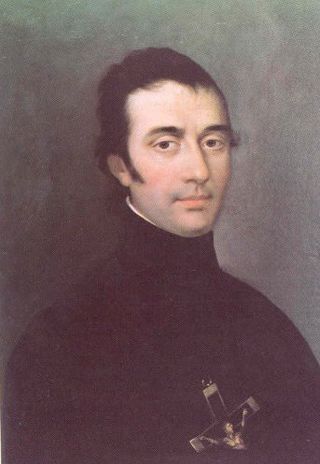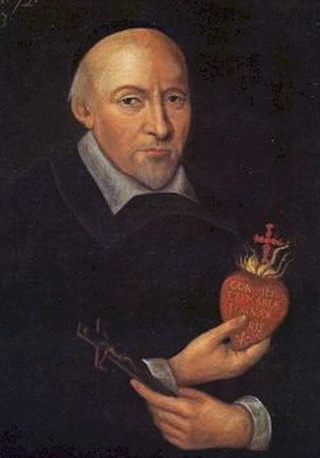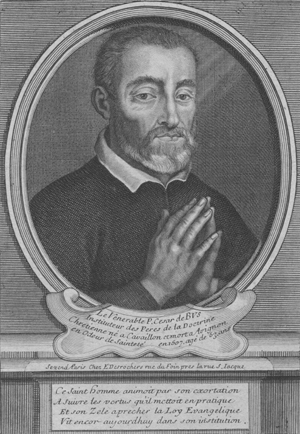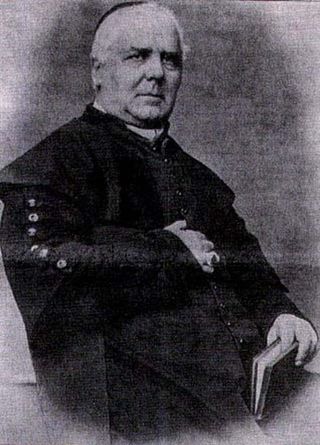
Guillaume-Joseph Chaminade, SM was a French Catholic priest who survived persecution during the French Revolution and later founded the Society of Mary, usually called the Marianists, in 1817. He was beatified by Pope John Paul II on 3 September 2000. His feast day is celebrated on 22 January.

Eugène de Mazenod, OMI was a French aristocrat and Catholic bishop. Mazenod founded the congregation of the Missionary Oblates of Mary Immaculate.

Peter Julian Eymard was a French Catholic priest and founder of two religious institutes: the Congregation of the Blessed Sacrament for men and the Servants of the Blessed Sacrament for women.

Luçon is a commune in the Vendée department, Pays de la Loire region, western France. Its inhabitants are known as Luçonnais.

John Eudes, CIM was a French Roman Catholic priest and the founder of both the Order of Our Lady of Charity in 1641 and Congregation of Jesus and Mary, also known as The Eudists, in 1643. He was also a professed member of the Oratory of Jesus until 1643 and the author of the proper for the Mass and Divine Office of the Sacred Hearts of Jesus Christ and the Blessed Virgin. Eudes was an ardent proponent of the Sacred Hearts and dedicated himself to its promotion and celebration; the Masses he compiled for both Sacred Hearts were both first celebrated within his lifetime. He preached missions across France, including Paris and Versailles, while earning recognition as a popular evangelist and confessor. Eudes was also a prolific writer and wrote on the Sacred Hearts despite opposition from the Jansenists.

Jean-Marie Robert de La Mennais, FICP was a Breton Catholic priest and brother of the philosopher Felicité Robert de Lamennais, whom he influenced in their youth. He was a leading figure in the revival of the Catholic Church in France after the French Revolution, involved in founding three religious institutes as part of this effort.

Chavagnes International College is an independent Catholic secondary school for boys, located in Chavagnes-en-Paillers, France. Founded in 1802 by Louis-Marie Baudouin the school was re-fashioned an "international college" in 2002. The school's language of instruction is English, and it prepares pupils for British GCSEs and A-levels, with the French Brevet and Baccalauréat as options.

The Diocese of Luçon is a Latin Church diocese of the Catholic Church in France. Its see is Luçon Cathedral in the commune of Luçon. The diocese comprises the department of Vendée. Created in 1317 out of the diocese of Poitiers, its existence was interrupted during the French Revolution, but it was restored in 1821, along with the Bourbon restoration.

The former Catholic diocese of Maillezais in north-west France was erected in 1317, by Pope John XXII, and ceased to exist in 1648 when it was incorporated into the new diocese of La Rochelle. The town of Maillezais is now found in the department of Vendée, and most of the territory of the former diocese belongs to the diocese of Luçon.

The Diocese of La Rochelle and Saintes is a Latin Church diocese of the Catholic Church in France. The diocese comprises the département of Charente-Maritime and the French overseas collectivity of Saint-Pierre and Miquelon. The bishop is a suffragan of the Archbishop of Poitiers. The episcopal seat is in La Rochelle Cathedral. Saintes Cathedral is a co-cathedral.

Chavagnes-en-Paillers is a commune of the Vendée department in the Pays de la Loire region in western France.

César de Bus was a French Catholic priest and founder of two religious congregations.

Louis-Marie Grignion de Montfort, TOSD was a French Catholic priest known for his preaching and his influence on Mariology. He was made a missionary apostolic by Pope Clement XI. Montfort wrote a number of books which went on to become classic Catholic titles and influenced several popes. His most notable works regarding Marian devotions are contained in Secret of the Rosary and True Devotion to Mary.

Louis Brisson, OSFS was a French Roman Catholic priest and the founder of both the Oblate Sisters of St. Francis de Sales and the Oblates of St. Francis de Sales. He founded the female branch alongside Léonie Aviat and the male branch alongside the Servant of God Thérèse Chappuis. Brisson's founding of the congregations stemmed from his desire to improve the working conditions of middle-class girls and to ensure their protection and the promotion of their faith.

Lodovico Pavoni was an Italian Roman Catholic priest who administered in Brescia where he lived. He paid close attention to the needs of males and was concerned with their education. He was to establish – in 1825 – his own religious congregation to assist in his mission: the Sons of Mary Immaculate which came to be known also as the "Pavoniani".
Charles Aimé de Royrand became a Vendean leader in the War in the Vendée, a revolt against the French Revolution. He joined the French Royal Army and served in an infantry regiment during the American Revolutionary War before retiring to his estates in 1780. When the Vendean insurrection broke out in 1793 he was chosen as the leader of the southern army. He led rebel forces at Luçon, Cholet and Entrames. He was fatally wounded at Entrames on 26 October and died at Baugé-en-Anjou.

Zefirino Agostini was an Italian Roman Catholic priest that served in his hometown of Verona to perform his pastoral duties. He established two religious congregations in his lifetime being the Pious Union of Sisters Devoted to Saint Angela Merici and the Ursuline Sisters of the Daughters of Mary Immaculate.

The Martyrs of Laos are seventeen Catholic priests and professed religious as well as one lay young man venerated as martyrs killed in Laos between 1954 and 1970 of the First and Second Indochina Wars during a period of anti-religious sentiment under the Pathet Lao Theravada Buddhist-communist political movement.
















